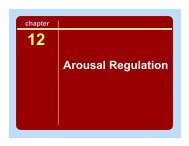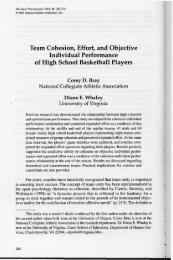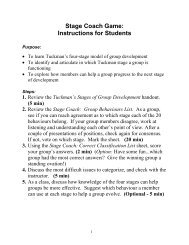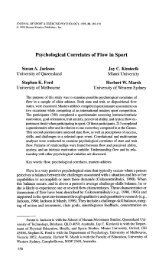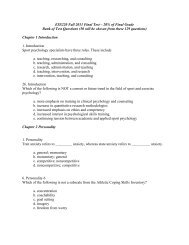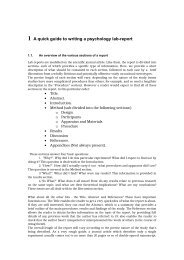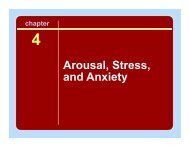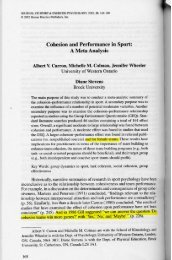Sport and Exercise Psychology Review - Sport Psychology Goes to ...
Sport and Exercise Psychology Review - Sport Psychology Goes to ...
Sport and Exercise Psychology Review - Sport Psychology Goes to ...
Create successful ePaper yourself
Turn your PDF publications into a flip-book with our unique Google optimized e-Paper software.
Mark A. Uphill & Marc V. Jones<br />
Results<br />
The effectiveness of the intervention was<br />
analysed using visual <strong>and</strong> statistical techniques.<br />
All data were graphed <strong>and</strong> analysed.<br />
For brevity, only those results demonstrating<br />
a large effect size are illustrated (see<br />
Figure 1). Visual inspection followed guidelines<br />
outlined by Martin <strong>and</strong> Pear (1996).<br />
Although visual inspection may reduce the<br />
likelihood of identifying small treatment<br />
effects (Baer, 1977), the use of visual inspection<br />
alone <strong>to</strong> judge the efficacy of an intervention<br />
is controversial (Gottman, 1981).<br />
Accordingly, two complementary analyses<br />
were completed <strong>to</strong> evaluate the statistical <strong>and</strong><br />
practical significance of the intervention<br />
respectively. First, in the absence of serial<br />
dependency, 2 pre- <strong>and</strong> post-intervention data<br />
were analysed using paired-samples t-tests (a<br />
Bonferroni correction was used <strong>to</strong> control for<br />
inflation of type 1 error, adjusted alpha =<br />
.003). Second, effect sizes were calculated 3<br />
<strong>and</strong> evaluated using the benchmarks provided<br />
by Cohen (1977). Specifically, an effect<br />
size of less than 0.2 is designated small, 0.5 is<br />
moderate, <strong>and</strong> 0.8 or greater is large. Finally,<br />
social validation of the intervention was<br />
assessed via the administration of the sport<br />
psychologist consultant evaluation form<br />
(Parting<strong>to</strong>n & Orlick, 1987), <strong>and</strong> an e-mail<br />
from the participant 24 months later.<br />
Figure 1 illustrates there was an immediate<br />
reduction in the relative frequency of<br />
careless shots post-intervention <strong>and</strong> few overlapping<br />
data points. Indeed, the ratio of<br />
careless shots <strong>to</strong> holes played decreased by<br />
52 per cent post-intervention. Statistically,<br />
the difference in careless shots pre- <strong>and</strong> postintervention<br />
was not significant (t(5) = 2.47,<br />
p = .06), although a large effect size (ES =<br />
1.37) was demonstrated. Besides an objective<br />
improvement in performance, the participant<br />
reported an improvement in performance<br />
attributes post-intervention. Enhanced<br />
pre-shot concentration was evident postintervention<br />
although this conclusion should<br />
be tempered with appropriate caution given<br />
the number of overlapping data points. Statistically<br />
the improvement was not significant<br />
(p = .07) although the magnitude of the<br />
difference (ES = -1.36) suggests that the<br />
improvement was of practical significance <strong>to</strong><br />
the performer. For motivation <strong>and</strong> post-shot<br />
concentration particularly, the effect was<br />
immediate <strong>and</strong> there were few overlapping<br />
data points pre- <strong>to</strong> post-intervention. Practically<br />
significant improvements post-intervention<br />
were exhibited for all performance<br />
attributes (see Table 1). In addition, statistically<br />
significant improvements were demonstrated<br />
for motivation (t(5) = -5.59, p =<br />
.003), <strong>and</strong> post-shot concentration (t(5) =<br />
-12.42, p = .001).<br />
The intervention generally did not<br />
achieve a marked reduction in the intensity<br />
of the participant’s emotional state (see<br />
Table 1), with mean scores remaining similar,<br />
or in some cases increasing marginally<br />
2<br />
Serial dependency is a property of single subject studies whereby sequential responses by the<br />
same participant will be correlated (Ottenbacher, 1986). Because t-tests assume that each data<br />
point is independent, it would only be appropriate <strong>to</strong> use a t-test in situations where the data<br />
are not serially dependent. To determine if data was serially dependent an au<strong>to</strong>correlation<br />
coefficient was calculated for each of the dependent variables <strong>and</strong> Bartlett’s test was used <strong>to</strong><br />
determine if the au<strong>to</strong>correlation coefficient was significant (Ottenbacher, 1986). Using this<br />
approach, it was calculated that serial dependency existed when the au<strong>to</strong>correlation coefficient<br />
was above 0.82.<br />
3<br />
Although a number of different approaches have been proposed <strong>to</strong> calculate effect size, the<br />
method suggested by Kazis, Anderson <strong>and</strong> Meenan (1989; cited in Hevey & McGee, 1998) was<br />
employed. Given the sometimes large variability observed in the baseline data of the present<br />
study, this was considered the most conservative estimate of effect size. Specifically, increases in<br />
st<strong>and</strong>ard deviations of baseline data decrease the estimated effect size for equivalent mean scores.<br />
18 <strong>Sport</strong> & <strong>Exercise</strong> <strong>Psychology</strong> <strong>Review</strong> Vol 1 No 2



